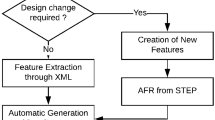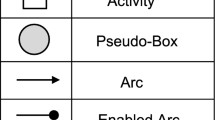Abstract
De-manufacturing (DM) is a process to separate a product into components and materials that will be maintained, replaced, reused, or recycled. Disassembling a selected set of parts in a product, defined as selective-disassembly, is an essential need in product DM. Although it is necessary to have an efficient and optimized sequence planning for selective-disassembly to reduce DM-related cost, it is more important to consider de-manufacturability for product life cycle cost at the early stage of a product development. However, the product analysis related to DM is generally regarded as a post-process in product development. Current product development environments require all industry in a supply chain to concurrently develop their specialized components corresponding to the end item requirement within a short time frame. Therefore, it is an emerging issue to add global concurrent de-manufacturability analysis into product development environments. An efficient sequence planning approach and a supporting tool are highly demanded. This paper presents a hybrid approach to selective-disassembly sequence planning for DM, which is based on both topological disassemblability and tool accessibility. In addition, a Web-based application on a three-tier Internet environment is implemented for the global concurrent de-manufacturability analysis.
Similar content being viewed by others
References
Srinivasan H, Gadh R (1998) A geometric algorithm for single selective disassembly using the wave propagation abstraction. Comput Aided Des 30:603–613
Srinivasan H, Figueroa R, Gadh R (1999) Selective disassembly for virtual prototyping as applied to de-manufacturing. Robot Comput Integr Manuf 15:231–245
Hao JP, Yu YL, Xue Q (2002) A maintainability analysis visualization system and its development under the AutoCAD environment. J Mater Process Technol 129:277–282
Garcia AM, Larre A, Lopez B, Oller A (2000) Reducing the complexity of geometric selective disassembly. Proc IEEE/RSJ International Conference on Intelligent Robots and Systems, Japan, Takamatsu pp 1474–1479
Mascle C, Balasoiu B (2003) Algorithmic selection of a disassembly sequence of a component by a wave propagation method. Robot Comput Integr Manuf 19:439–448
Miller JM, Hoffman RL (1989) Automatic assembly planning with fasteners. Proc IEEE International Conference on Robotics and Automation, AZ, Scottsdale pp 69–74
Wilson HR (1998) Geometric reasoning about assembly tools. Artif Intell 98:237–279
Akagi F, Osaki H, Kikuchi S (1980) The method of analysis of assembly work based on the fastener method. Bull JSME 23:1670–1675
Gui JK, Mantyla M (1994) Functional understanding of assembly modeling. Comput Aided Des 26:435–451
Kuo TC (2000) Disassembly sequence and cost analysis for electromechanical products. Robot Comput Integr Manuf 16:43–54
Tseng HE, Li RK (1999) A novel means of generating assembly sequences using the connector concept. J Intell Manuf 10:423–435
Yin ZP, Ding H, Li HX, Xiong YL (2003) A connector-based hierarchical approach to assembly sequence planning for mechanical assemblies. Comput Aided Des 35:37–56
Homen De Mello LS, Sanderson AC (1991) A correct and complete algorithm for the generation of mechanical assembly sequences. IEEE Trans Robot Automat 7:228–240
Zhang S, Shen W, Ghenniwa H (2004) A review of Internet-based product information sharing and visualization. Comput Ind 54:1–15
Huang GQ, Lee SW, Mak KL (1999) Web-based product and process data modeling in concurrent “design for X”. Robot Comput Integr Manuf 15(1):53–63
Huang GQ, Mak KL (1999) Design for manufacture and assembly on the Internet. Comput Ind 38(1):17–30
Huang GQ, Nie M, Mak KL (1999) Web-based failure mode and effect analysis (FMEA). Comput Ind Eng 37:177–180
Zeng J, Chen W, Ding Q (2003) A web-based CAD system. J Mater Process Technol 139:229–232
Evans E, Rogers D (1997) Using Java applets and CORBA for multi-user distributed applications. IEEE Internet Comput 1(3):43–55
Chung C, Peng Q (2004) The selection of tools and machines on web-based manufacturing. Int J Mach Tools Manuf 44(2–3):315–324
Qiu ZM, Chen YP, Zhou ZD, Ong SK, Nee AYC (2001) Multi-user NC machining simulation over the WWW. Int J Adv Manuf Technol 18:1–6
Ong SK, Jiang L, Nee AYC (2002) An internet-based virtual CNC milling system. Int J Adv Manuf Technol 20:20–30
Huang GQ, Mak KL (2001) Issues in the development and implementation of Web applications for product design and manufacture. Int J Comput Integr Manuf 14(1):125–135
Gottschalk S, Lin MC, Manocha D (1996) OBB-Tree: a hierarchical structure for rapid interference detection. Proc the 23rd annual conference on Computer Graphics and Interactive Techniques, New York, NY, pp 171–180
Möller T (1997) A fast triangle-triangle intersection test. J Graphics Tools 2:25–30
Mo J, Zhang Q, Gadh R (2002) Virtual disassembly. Intl J CAD/CAM 2(1):29–37
Pomares J, Puente ST, Torres F, Candelas FA, Gil P (2004) Virtual disassembly of products based on geometric models. Comput Ind 55:1–14
MIL-HDBK-472 (1966) Maintainability prediction. Department of Defense (DoD), USA
NASA-STD-8729.1 (1998) Planning, developing and managing an effective reliability and maintainability (R&M) program. National Aeronautics and Space Administration (NASA), USA
MIL-STD-470B (1989) Maintainability program for systems and equipment, DoD, USA
Author information
Authors and Affiliations
Corresponding author
Rights and permissions
About this article
Cite this article
Chung, C., Peng, Q. A hybrid approach to selective-disassembly sequence planning for de-manufacturing and its implementation on the Internet. Int J Adv Manuf Technol 30, 521–529 (2006). https://doi.org/10.1007/s00170-005-0038-5
Received:
Accepted:
Published:
Issue Date:
DOI: https://doi.org/10.1007/s00170-005-0038-5




